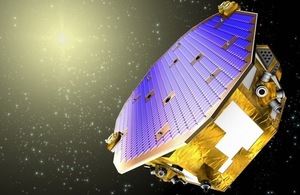LISA Pathfinder (LPF)
LPF was an ESA mission launched in 2015 to demonstrate the ultra-high precision technology needed for a future space-based gravitational wave observatory, LISA (Laser Interferometer Space Antenna). LPF also carried a payload provided by NASA.

Artist's impression of LISA Pathfinder spacecraft. Credit: ESA.
Gravitational waves are ripples in space-time, thought to be generated by violent astrophysical events such as exploding stars and collisions of black holes at the centre of galaxies. They were first predicted by Einstein’s Theory of General Relativity in 1916 but were only detected for the first time in 2015 by ground-based observatories.
This discovery offers scientists an entirely new way of observing the Universe, even for large scale events billions of light years away and objects that emit no light such as black holes. Ground based observations are limited by background gravitational noise and by the curvature of the Earth, because measurements must be made over vast distances to detect these tiny perturbations, and they can only be used to detect the highest frequency gravitational waves. This means that the ability to observe cataclysmic events in space is still limited.
To capture the lower frequency waves and study them in more detail a space-based observatory is needed. This will require three spacecraft flying in a triangular formation with a laser metrology system linking them that is capable of measuring with unprecedented precision, to a few millionths of a millionth of a metre, over distances of 1.5 million km. It also requires test masses to be housed inside the spacecraft in gravitational free fall, isolated entirely from all other gravitational effects from their surroundings (including those of the spacecraft itself). This means that any changes in distance between the test masses measured by the lasers can only be due to the passage of gravitational waves, causing the fabric of space and time to stretch and contract. Because the technology requirements are so demanding, ESA launched Pathfinder to prove it could be done before embarking on the much larger LISA mission.
The 9 month LISA Pathfinder mission was a great success, exceeding all expectations and demonstrating conclusively in 2016 that the measurement principles needed for LISA would work. The UK contributed substantially to this success, with teams at Glasgow, Birmingham and Imperial College London contributing core elements of the payload, funded by the UK Space Agency. The Glasgow team built the optical bench for the metrology system and won the prestigious Sir Arthur Clarke award in 2016 for Space Achievement in Academic Research. Birmingham contributed the phasemeter and Imperial College the Charge Management System, all of which performed well in excess of requirements. Astrium (now Airbus Defence & Space UK) built the spacecraft under contract to ESA, with SciSys Ltd providing the onboard software.
Updates to this page
-
Mission information updated.
-
First published.